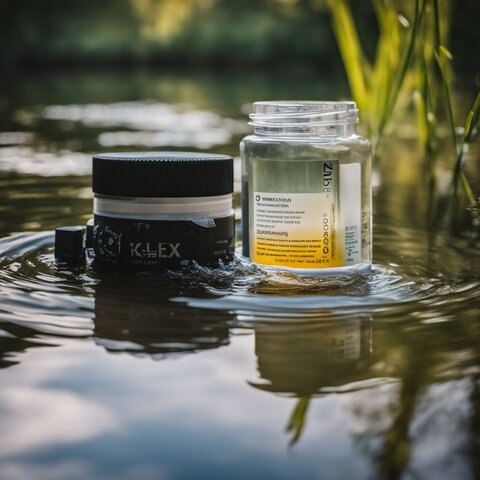
How To Raise pH In A Pond
Knowing how to raise pH in a pond will help you maintain a healthy environment for the ecosystem.
The ideal pH level for a pond should be between 6.5 and 8.5 to ensure a healthy environment for fish and aquatic plants.
Our guide offers straightforward steps to adjust and stabilize your pond’s pH, ensuring it remains a thriving ecosystem for its inhabitants.
Keep reading to discover how simple managing pond pH can be!
Understanding pH and Alkalinity in a Pond
pH measures how acidic or basic the water in your pond is, on a scale from 0 to 14.
Neutral water has a pH of 7, while anything below is considered acidic and above, alkaline.
The best range for pond life, including fish and plants, falls between 6.5 and 8.5.

Maintaining a pH within this range supports the well-being of fish and contributes to a stress-free environment.
Alkalinity acts like a buffer against sudden pH changes in your pond's water.
It’s measured by its capacity to neutralize acids; higher alkalinity means more stable pH levels.
For healthy ponds, total alkalinity should generally be above 20 ppm (parts per million), though optimal ranges can vary based on specific pond ecosystems and the needs of its inhabitants.
Stable conditions prevent fish stress and maintain an environment where essential nutrients are available for aquatic life.
Next up: Recognizing when your pond has low pH issues becomes crucial for maintaining healthy waters.
Identifying the Signs of a Low pH
Fish acting stressed or sick can be a sign that your pond's pH is too low. You might notice them moving less or gasping for air at the surface.
This happens because a low pH level, below 6.5, affects their health badly.

The water might also look clearer than usual but don't let this fool you into thinking it's healthy.
Another clue is if plants in the pond start to die off or look unhealthy. They need certain pH levels to absorb nutrients properly.
If algae grow less and leaves begin to yellow, it could mean the pH has dropped too much.
Testing the water regularly helps catch these issues early on before they harm fish and plants more.
Now, understanding what factors contribute to lowering your pond’s pH will help you prevent it from happening again.
Factors that Can Increase the Risk of a Low pH
After spotting the signs of low pH in your pond, it's crucial to understand what might be causing this issue.
Heavy rain over a long period can wash acids into the pond, lowering the pH value.

Using soft water to refill or top off the pond also contributes to decreased pH levels due to its lower mineral content.
Additionally, fluctuations in water quality can lead to sudden drops in pH, stressing aquatic life.
Understanding these factors helps you take steps toward stabilizing your pond's environment.
Another risk factor comes from beneath—the soil itself.
Acidic soils surrounding your pond can leach into the water, especially after rainfall, pushing the pH down further.
This situation calls for regular soil testing near and around your pond area.
By keeping an eye on these contributing elements—rainfall patterns, water source characteristics, and surrounding soil acidity—you're better equipped to manage and prevent low pH conditions that could harm fish and plant life in your pond.
Methods to Raise pH in a Pond
To raise the pH in your pond, start by testing the soil. This will guide you in choosing the right liming agents for effective treatment.

Pond Soil Testing
Pond soil testing helps you understand the pond's current state before making changes to raise pH levels.
You grab a soil sample from the bottom of your pond and send it to a lab for analysis.
This test shows whether your pond's soil is acidic and needs treatment with liming agents like agricultural limestone or hydrated lime.
Knowing the exact condition of your pond’s soil can save time and effort in adjusting pH levels correctly.
Using accurate soil samples, you can determine how much limestone or other material you need to add.
This prevents over-application, which could harm fish and plants by causing sudden changes in water chemistry.
Soil tests also reveal other important information such as phosphorus availability, fertility, and clay content that affect water hardness and alkalinity.
Making informed decisions based on these results enhances the success rate of increasing the pond's pH safely for healthier fish life.
Using Liming Agents
Liming agents like quicklime, slaked lime, and calcium carbonate are great for raising pH in ponds.
These materials reduce acidity by adding calcium and magnesium to the water.
This action helps increase water hardness and buffering capacity, making the environment safer for fish.
Applying liming agents is a careful process. You must evenly spread them over the pond surface or mix them with pond soil if accessible.
The correct amount depends on your initial pH level and the hardness of your pond’s water.
Always test your water first to determine how much agent you need to use.
Timing of Application
Applying agricultural limestone to ponds during the winter months is best.
This timing allows the limestone enough time to dissolve and adjust the pH levels before spring.
Since it can take a few days to over a month for agricultural limestone to work, early application ensures your pond's water is ready when fish need it most.
Act quickly if your pond's pH falls below 6.5. Waiting too long can risk fish kills and disrupt the balance of life in your pond.
Early treatment helps prevent diseases and promotes healthy conditions for phytoplankton blooms, providing essential food for forage fish and maintaining overall ecosystem health.
Preventing a Pond pH Crash
Maintaining the right hardness of water is key to stopping a pH crash in your pond.
High alkalinity waters protect against sudden drops in pH by buffering the water.
Regularly test your pond's pH and keep it between 6.5 and 8.5 to ensure a stable environment for fish and plants.
Gradually adding liming agents can help increase alkalinity, providing a buffer against drastic pH changes, though it's important to monitor these additions closely to avoid overshooting the desired pH range.
Fertilizing correctly also plays a role in preventing pH swings.
Over-fertilization can lead to high levels of phosphate, promoting algae growth that consumes oxygen at night, increasing carbon dioxide, which lowers pH.
Plan fertilization carefully to avoid these spikes and keep your pond's ecosystem balanced.
Ensure proper retention time for fertilizers to be absorbed before they can alter the water chemistry significantly.
FAQs
What is pH and why is it important for my pond?
pH measures how acidic or basic the water in your pond is on a scale called the pH scale. Keeping the right pH level helps fish and plants stay healthy.
How can I raise the pH level in my pond?
You can raise the pH by adding materials like baking soda or agricultural lime, or by using water treatments designed to adjust pH levels. It's crucial to choose a method based on a comprehensive analysis of your pond's current conditions.
Does rain affect my pond's pH levels?
Yes, heavy rainfall can make your pond more acidic because it mixes with acid soils around your pond, lowering the pH values.
Can adding certain creatures to my pond help with its pH?
Adding zooplankton doesn't directly change the pH but they play a role in balancing ammonia levels which can influence overall water quality and indirectly impact pH through processes like nitrification.
Are there any risks of raising my pond's PH too much?
Yes, if you raise the PH too much it could lead to sickness among fish due to high ammonia or ammonium residues from over-adjustment. Always aim for a balanced approach when adjusting your pond’s PH.
Conclusion
Discovering how to raise pH in a pond helps keep fish happy and healthy.
Always check the water's pH if you notice fish acting weird. Use lime, baking soda, or adjusters after testing to fix low levels.
Keeping an eye on rain and water changes helps avoid sudden drops.
Remember, a balanced pond creates a thriving ecosystem for all its inhabitants.

